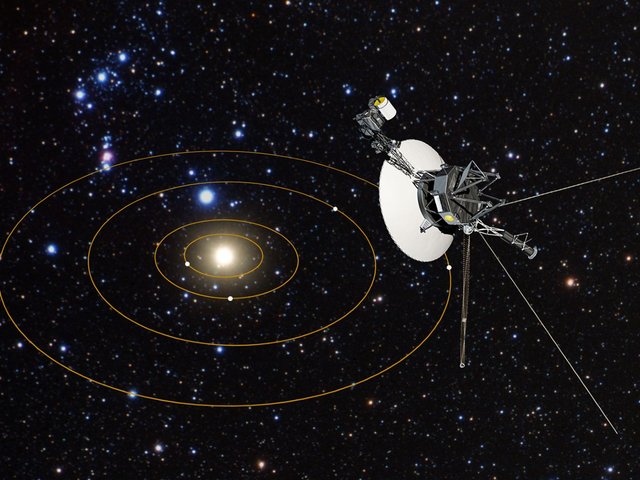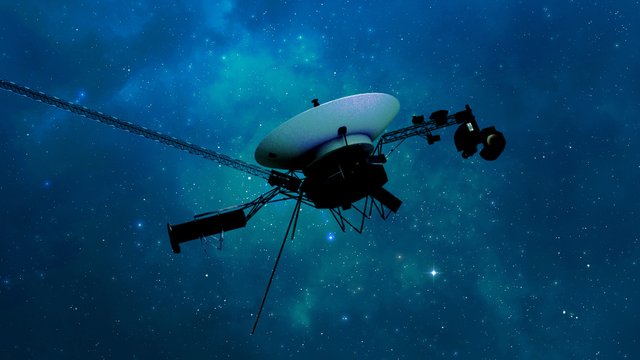Voyager 1 will be the first object to reach one light-day from Earth/Voyager 1 será el primer objeto en alcanzar un día luz desde la Tierra

Source
Voyager 1 was launched by NASA on September 5, 1977, from Cape Canaveral, Florida, as part of the Voyager program to explore the outer Solar System and interstellar space. The probe, a 722-kilogram robotic spacecraft, was initially tasked with closely studying Jupiter and Saturn, as well as their major moons. Thanks to gravitational assists along its journey, Voyager 1 accelerated enough to become the fastest and furthest human-made spacecraft from Earth, and has now passed beyond the limits of the Solar System.
La Voyager 1 fue lanzada por la NASA el 5 de septiembre de 1977 desde Cabo Cañaveral, Florida, como parte del programa Voyager para explorar el Sistema Solar exterior y el espacio interestelar. La sonda es una nave robótica de 722 kilos y su misión inicial era estudiar de cerca Júpiter y Saturno, así como sus lunas principales. Gracias a asistencias gravitacionales durante su trayecto, la Voyager 1 aceleró lo suficiente para convertirse en la nave más rápida y alejada de la Tierra creada por el ser humano y hoy día ya ha sobrepasado los límites del Sistema Solar.
A light-day is the distance light travels in 24 hours, which is approximately 25.92 billion kilometers. To give you an idea, light from the Sun takes about 8 minutes to reach Earth, but a radio message from Voyager 1 will take more than 24 hours to reach us by that point. This highlights the vastness of space; Voyager, launched in 1977, has taken almost 50 years to cover the distance light travels in a day. It seems that Voyager 1 is about to reach that light-day, making it the only object to reach that distance from Earth.
Un día luz es la distancia que recorre la luz en 24 horas, que equivale a aproximadamente 25.920 millones de kilómetros. Para que os hagáis una idea, la luz del Sol tarda unos 8 minutos en llegar a la Tierra, pero un mensaje de radio desde la Voyager 1 tardará más de 24 horas en alcanzarnos cuando llegue a ese punto. Esto resalta lo vasto que es el espacio: ¡la Voyager, lanzada en 1977, ha tardado casi 50 años en cubrir esa distancia que la luz hace en un día. Pues parece que la sonda Voyager 1 está a punto de alcanzar ese día luz, lo que lo convierte en el objeto en alcanzar esa distancia desde la Tierra.

Source
According to precise NASA calculations and simulations such as Eyes on the Solar System, Voyager 1 will reach exactly one light-day from Earth on November 15, 2026. As of October 2025, the probe is approximately 25.2 billion km (15.5 billion mi) from Earth (approximately 168 AU), meaning it takes over 23 hours for radio signals to reach it. Traveling at approximately 61,000 km/h (38,000 mph), it is the most distant human-made object on the planet. This achievement highlights the capabilities of human engineering and the scope of robotic exploration. Voyager 1 has survived nearly 50 years of mission, surpassing technical, scientific, and cultural milestones.
Según cálculos precisos de la NASA y simulaciones como Eyes on the Solar System, la Voyager 1 alcanzará exactamente un día luz de la Tierra el 15 de noviembre de 2026. A fecha de octubre de 2025, la sonda se encuentra a unos 25.200 millones de km de la Tierra (aproximadamente 168 UA), lo que significa que las señales de radio tardan más de 23 horas en llegar. Viaja a unos 61.000 km/h y es el objeto humano más lejano del planeta. Este logro destaca las capacidades de la ingeniería humana y el alcance de la exploración robótica, la Voyager 1 ha sobrevivido casi 50 años de misión, superando hitos técnicos, científicos y culturales.
This probe has a twin sister, Voyager 2, which, curiously, was launched first (August 20, 1977), but Voyager 1 took a faster trajectory, arriving at Jupiter earlier. They were launched by NASA taking advantage of a rare alignment of the outer planets that only occurs every 175 years, which allowed the spacecraft to use gravitational assists to propel themselves from planet to planet. Both visited Jupiter (in 1979) and Saturn in 1980 and 1981, respectively, providing unprecedented images and data. Voyager 1 focused on a close flyby of Saturn's moon Titan, which deflected it out of the plane of the ecliptic.
Esta sonda tiene una hermana gemela, la Voyager 2 que, curiosamente, fue lanzada primero (20 de agosto de 1977), pero la Voyager 1 tomó una trayectoria más rápida, llegando antes a Júpiter. Fueron lanzadas por la NASA aprovechando una rara alineación de los planetas exteriores que solo ocurre cada 175 años, lo que permitió a las naves usar la asistencia gravitatoria para impulsarse de planeta en planeta. Ambas visitaron Júpiter (en 1979) y Saturno en 1980 y 1981, respectivamente, proporcionando imágenes y datos sin precedentes. La Voyager 1 se centró en un sobrevuelo cercano a Titán, la luna de Saturno, que la desvió fuera del plano de la eclíptica.

Source
As a curious fact about Voyager 1, it carries a gold-plated copper disc with sounds and images of Earth (music from Bach to Chuck Berry, greetings in 55 languages, and photos of whales and cities). It's like a time capsule for potential extraterrestrials. Carl Sagan called it "a bottle thrown into the cosmic ocean." Personally, I don't think this is a very good idea. If other civilizations are anything like ours, I'd rather they don't find the bottle with the message, since most likely, if they do, they'll come and massacre us.
Como dato curiosos sobre la Voyager 1, lleva un disco de cobre chapado en oro con sonidos e imágenes de la Tierra (música de Bach a Chuck Berry, saludos en 55 idiomas, y fotos de ballenas y ciudades). Es como una cápsula del tiempo para posibles extraterrestres. Carl Sagan lo llamó "una botella lanzada al océano cósmico". Personalmente esto no me parece muy buena idea, si el resto de civilizaciones se parecen a la nuestra prefiero que no encuentren la botella con el mensaje, ya que lo más probable es que si lo encuentran vengan y nos masacren.
But what this fact really shows us is the immensity of outer space. It took us almost 50 years to travel one light-day and escape the influence of the Sun. Now, consider that Alpha Centauri, the closest star to us, is just over 4 light-years away. Using a simple rule of three, we'll see that if it takes 50 years to travel one light-day, the trip to Alpha Centauri would take us more than 70,000 years. That's why I find it so hard to believe that aliens visit us in their ridiculous flying saucers.
Pero lo que realmente nos muestra este hecho es la inmensidad del espacio exterior, hemos tardado casi cincuenta años en recorrer un día luz y salirnos de la influencia del Sol. Ahora tengamos en cuenta que Alfa Centauri, que es la estrella que tenemos más cerca de nosotros, está a algo más de 4 años luz. Con una regla de tres sencilla veremos que si se tarda 50 años en recorrer un día luz, el viaje a Alfa Centauri nos llevaría más de setenta mil años. Por eso me cuesta tanto creer que los extraterrestres nos visitan en sus ridículos platillos volantes.
More information/Más información
https://www.africaninspace.com/space/nasas-voyager-spacecraft-will-make-history-in-november-2026-as-the-first-object-to-reach-a-light-day-from-earth-49165/
https://www.eluniverso.com/estados-unidos/estilo-de-vida/nave-espacial-voyager-de-la-nasa-nota/
Voyager 1 expiry date has been long due and it is still giving signals, which is really a marvelous achievement of the technology that we humans have developed. Very soon, Voyager 1 will be out of Earth's reach and we will no longer receive signals, not because it will be out of order, but it will be out of reach. And if there is any life somewhere out there, may be they will find it some day.
It really is a spectacular achievement, but leaving clues about where we are scares me quite a bit, even if the aliens are half as bad as we are we are doomed.
0.00 SBD,
0.14 STEEM,
0.14 SP